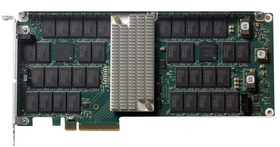NetApp Flash Cache (previously known as the Performance Acceleration Module II, or PAM II) is simply 256 GB or 512 GB of SLC NAND flash on a PCIe x8 card. It plugs into NetApp filers. They use it to cache hot data to accelerate read operations. See picture. Pretty simple, right?

Flash Cache is very effective at improving overall performance, mostly because the amount of memory contributing to caching in a NetApp filer (usually 8-32 GB) tend to be small compared to Flash Cache. For example, NetApp published benchmarks comparing one of their Fiber Channel solution with a SATA + Flash Cache one. The latter matches its performance, with half the drives, one third the power consumption, and at half the price, thanks to its solid-state cache!
In fact, Flash Cache is so effective that NetApp, fearing this would impact their high-end filers sales, decided to sell it at a 40x markup: a 256 GB Flash Cache costs $40k instead of $1k for similar SLC NAND flash-based products as found in markets where vendor competition actually takes place (read: SSDs at $4/GB). The irony is that NetApp says, in the Flash Cache overview linked above: "for most applications it's hard to justify the cost [...] of SSDs", then goes on to introducing Flash Cache as the solution. Hmm. I think you are wrong, NetApp. SSDs are 1/40th the cost :-)
More seriously —who has not seen a marketing department commit a gaffe ?— this is a sad example of what a closed proprietary storage vendor can force upon his customers... Some will say that the high price tag is justified by the incredible performance, but they miss the point. This performance can be had, at $4/GB, from competing products such as Linux storage servers with bcache, or ZFS storage servers which L2ARC cache devices. Both allow end-users to configure any number and any type of solid-state storage devices as cache devices. In the end, this is a usual tradeoff: the prospective customer should ask herself if the NetApp feature set is worth a 40x markup or not.